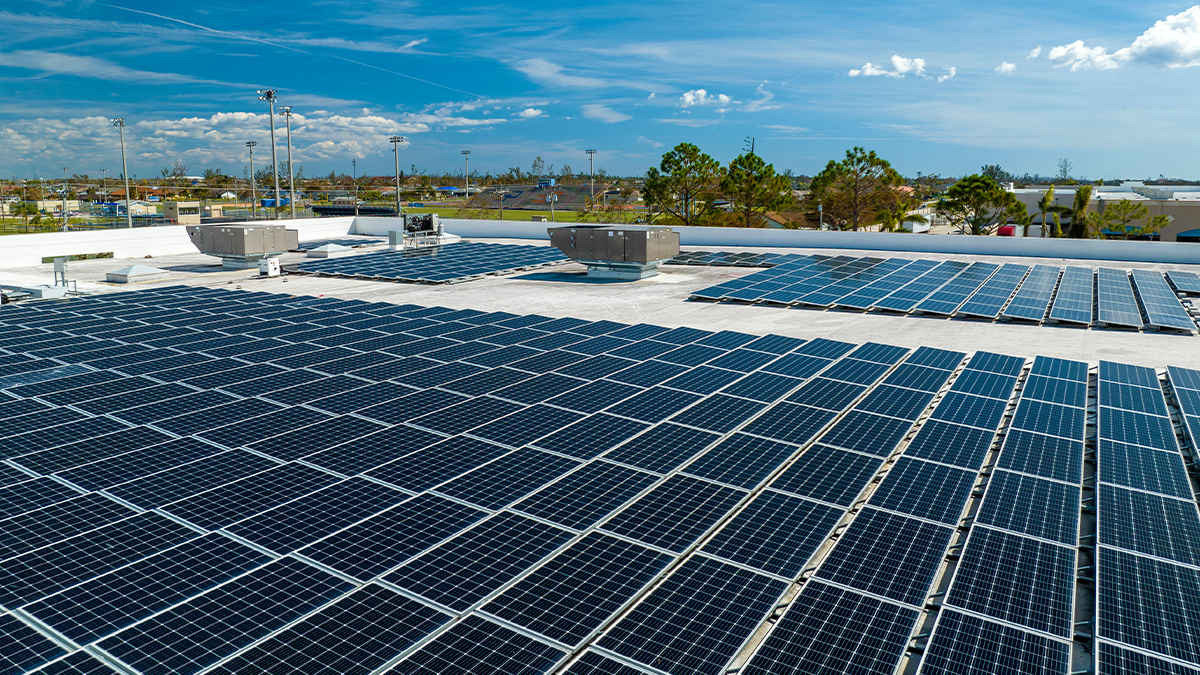
In 2022, the aviation industry generated 800 megatons of carbon emissions. That’s 800 billion kilograms of carbon dioxide, or 2% of all global emissions.
But as the industry rebounds from the drop in air travel during the pandemic, it aspires to come back stronger—and cleaner. The 193 member states of the International Civil Aviation Organization (ICAO) in 2022 adopted a long-term global aspirational goal to achieve net zero carbon emissions from international aviation by 2050.
Net Zero 2050 is an ambitious goal. The vast majority of aviation emissions come from jet kerosene, which has proved difficult to replace as an energy source for aircraft, despite ongoing research into electric- and hydrogen-powered aircraft.
But the aviation industry can make immediate impacts on emissions by reducing the carbon footprint of its airports and infrastructure. And Aeroporti di Roma (ADR), operator and developer of Rome Fiumicino and Rome Ciampino airports, is at the forefront of this effort.
Blue Skies Ahead
Fossil fuels remain the dominant source of energy for industry, accounting for about 65% of the global industrial sector’s energy mix in 2022. Yet the numerous geopolitical and environmental conditions increasing the costs of these fossil fuels, and the need to meet sustainability standards, are driving organizations to seek alternative energy sources.
For any organization with high sustainability goals, the shift to clean electrification entails complexity and cost, which can hurt competitiveness in the short term.
Organizations that commit to using renewable sources of energy often find themselves engaging with multiple specialist partners offering narrow energy-management services. One partner might provide advisory services, another might help plan and install infrastructure, and a third might provide energy storage solutions.
Working with such siloed partners may prevent collaborative cohesion, which can increase both the complexity of energy management and the cost that the partnerships were meant to alleviate.
Cleared for Takeoff
That is the paradox ADR wanted to avoid when it embarked upon its ambitious strategy to attain net zero emissions by 2030—well ahead of targets set by the European airport sector.
Like many organizations, ADR chose to partner not with a network of specialist vendors but with a single full-service energy-management organization. Enel X Global Retail provides advanced energy services and technology to consumers, businesses, and cities around the world to help them become more energy efficient, reduce their energy and operational spending, and monetize any excess clean-electricity production.
At the start of the collaboration, after analyzing ADR’s energy needs and goals, Enel X Global Retail had established insights to help it build ADR a roadmap to net zero and a recommendation of custom solutions. The partnership led to a significant determination: that ADR’s best energy-management solution would be a large photovoltaic system at Fiumicino Airport that would generate electricity from the region’s ample sunlight.
Enel X Global Retail didn’t just plan this plant—it’s also building it. When the plant is completed in 2024, it will be the largest of its kind in Europe. The centerpiece of the plant, the massive photovoltaic system located next to one of the airport’s runways, will allow ADR to produce its own renewable energy on-site, cut its energy costs, and reduce its contribution to carbon emissions.
The plant’s photovoltaic system will comprise 55,000 solar panels covering 84 acres and will produce 32 gigawatt hours of renewable electricity per year, with a maximum 22-megawatt peak output. The plant will also include mounting systems, cabins, and cable ducts for the solar panels.
Enel X Global Retail uses an open innovation model to boost electrification. The organization is providing ADR the energy-management software that can help optimize the plant’s operations, enable predictive maintenance, and avoid shutdowns. It’s also providing solutions that could help ADR trade excess self-produced electricity on the open market to derive even greater value from the clean-energy systems. Because solar panels only generate electricity when the sun is shining, ADR’s solar plant will be integrated with an innovative 10-megawatt-hour battery energy-storage system based on used electric vehicle (EV) batteries. This system will store excess photovoltaic energy produced during the day, making it available to meet evening demand and maximizing the use of self-generated green electricity.
The payoff of this solution will be significant: ADR’s new plant will eliminate 11,000 tons of carbon emissions per year, equal to the carbon dioxide absorbed annually by planting 100,000 trees.
In addition to this photovoltaic system, ADR also plans to electrify its entire ground vehicle fleet, phase out its fossil fuel-powered cogeneration plant, and invest in providing low-carbon sustainable aviation fuel (SAF), made from renewable biomass and waste resources, by 2024.
The aviation industry has a long road ahead to achieving sustainability. But by working with a single energy partner with the breadth of experience and global presence to help it make meaningful energy reforms, ADR is charting the smoothest and most efficient path possible to aviation’s cleaner future.
Learn more about how Enel X Global Retail can help you achieve your net zero goals.